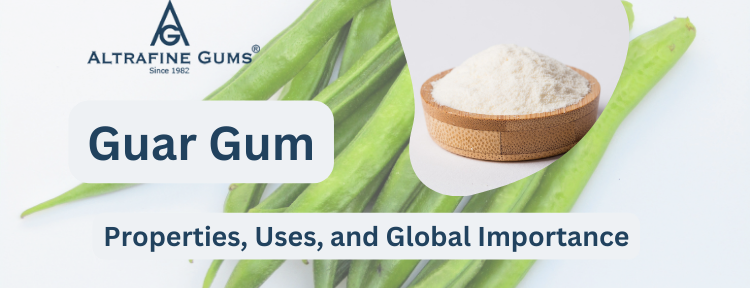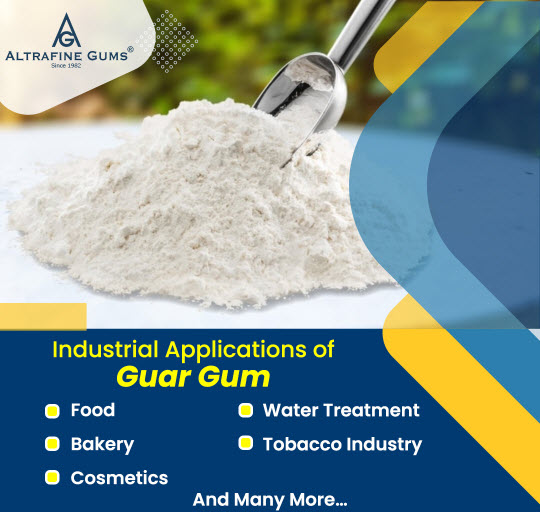- Home
- Guar Gum Powder
- What is Guar Gum? Exploring Its Properties, Uses, and Global Importance

What is Guar Gum? Exploring Its Properties, Uses, and Global Importance
Introduction
Guar Gum, a natural polysaccharide extracted from guar beans, has become an indispensable ingredient in various industries due to its unique thickening, gelling, and stabilizing properties. This article delves into what Guar Gum is, its chemical composition, extraction process, wide range of applications, and its global importance.
Understanding Guar Gum
Guar Gum, also known as guaran, is derived from the endosperm of the guar bean (Cyamopsis tetragonoloba). This legume is primarily grown in India and Pakistan, with India being the largest producer. Guar beans are valued not only for their gum content but also for their high protein content and use as animal feed.
Chemical Composition
Guar Gum is a galactomannan, composed of galactose and mannose sugars. The molecular structure of Guar Gum features a linear chain of β-D-mannopyranosyl units linked by (1→4) glycosidic bonds, with α-D-galactopyranosyl units attached by (1→6) glycosidic bonds. This structure allows Guar Gum to form highly viscous solutions even at low concentrations, making it an efficient thickening agent.
Extraction and Processing
The extraction of Guar Gum involves several steps:
- Harvesting: Guar beans are harvested and dried.
- De-husking: The outer shell of the beans is removed.
- Milling: The de-husked beans are split and the endosperm is separated from the germ and husk.
- Grinding: The endosperm is ground into a fine powder, which is then screened to obtain the desired particle size.
The final product is a white to yellowish-white, free-flowing powder that is water-soluble and has excellent thickening and emulsifying properties.
Applications of Guar Gum
Food Industry: Guar Gum is widely used in the food industry as a thickening, stabilizing, and emulsifying agent. It is found in products such as ice creams, sauces, dressings, and baked goods. Its ability to improve texture, enhance shelf-life, and prevent syneresis (water separation) makes it a valuable ingredient.
Pharmaceuticals: In the pharmaceutical industry, Guar Gum is used as a binder and disintegrator in tablet formulations. It also serves as a controlled-release agent in medications, allowing for the gradual release of active ingredients.
Cosmetics and Personal Care: Guar Gum is employed in personal care products such as shampoos, conditioners, and lotions for its thickening and stabilizing properties. It helps improve the viscosity and texture of these products.
Oil and Gas Industry: Guar Gum plays a crucial role in hydraulic fracturing (fracking) as a gelling agent. It helps in the creation of fractures in rock formations, facilitating the extraction of oil and natural gas.
Textile and Paper Industries: Guar Gum is used as a sizing agent in the textile industry, improving the strength and durability of fabrics. In the paper industry, it acts as a wet-end additive, enhancing the quality of the paper.
Exploration of New Applications: Research is ongoing to explore new applications for Guar Gum, including its potential use in biodegradable plastics, water treatment, and as a dietary fiber supplement in functional foods.
Global Market and Economic Importance
The global Guar Gum market is driven by its diverse applications across various industries. The primary markets for Guar Gum include the United States, Europe, China, and Japan. India’s dominance in Guar Gum production is a significant economic contributor, providing livelihoods for millions of farmers and workers in the processing industry.
Challenges in the Guar Gum Industry
Despite its widespread use and economic importance, the Guar Gum industry faces several challenges:
- Price Volatility: The prices of Guar Gum can be highly volatile, influenced by factors such as weather conditions, market demand, and speculative trading.
- Quality Control: Ensuring consistent quality across batches is critical, as variations can affect the performance of Guar Gum in end products.
- Sustainability: Sustainable farming practices are essential to maintain the long-term viability of Guar Gum production. Soil health, water usage, and crop rotation are important considerations.

The Future of Guar Gum
The future of Guar Gum looks promising with the continued exploration of new applications and markets. Innovations in processing technologies and the development of value-added products are expected to drive growth. Additionally, the increasing consumer preference for natural and organic ingredients is likely to boost demand for Guar Gum in various industries.
Conclusion
Guar Gum, with its unique properties and versatile applications, has established itself as a vital ingredient in numerous industries. Its ability to thicken, stabilize, and emulsify makes it invaluable in food, pharmaceuticals, cosmetics, and beyond. As global demand continues to rise, addressing challenges such as price volatility and quality control will be crucial. With ongoing innovation and a focus on sustainability, the future of Guar Gum remains bright, ensuring its continued significance in the global market.
FAQs – Guar Gum
Q1: What is Guar Gum?
Guar Gum is a natural polysaccharide extracted from the endosperm of guar beans. It is used as a thickening, stabilizing, and emulsifying agent in various industries.
Q2: What are the main applications of Guar Gum?
Guar Gum is widely used in the food industry, pharmaceuticals, cosmetics, oil and gas, and textile and paper industries. It serves as a thickening, stabilizing, and emulsifying agent.
Q3: How is Guar Gum extracted and processed?
Guar Gum is extracted by de-husking, milling, and grinding the guar beans to obtain a fine powder. The endosperm is separated and processed to produce the final product.
Q4: What makes Guar Gum a valuable ingredient in the food industry?
Guar Gum enhances the texture, consistency, and shelf-life of food products. It prevents syneresis and improves the overall quality of foods such as ice creams, sauces, and baked goods.
Q5: Why is Guar Gum important in the oil and gas industry?
In hydraulic fracturing (fracking), Guar Gum acts as a gelling agent, helping to create fractures in rock formations and facilitating the extraction of oil and natural gas.
Q6: What are the challenges faced by the Guar Gum industry?
The Guar Gum industry faces challenges such as price volatility, quality control, and the need for sustainable farming practices to ensure long-term viability.
Q7: What are the chemical properties of Guar Gum?
Guar Gum is a galactomannan composed of galactose and mannose sugars. Its structure allows it to form highly viscous solutions, making it an efficient thickening agent.
Q8: How is Guar Gum used in the pharmaceutical industry?
In pharmaceuticals, Guar Gum is used as a binder and disintegrator in tablets and as a controlled-release agent in medications.
Q9: What future prospects exist for Guar Gum?
The future of Guar Gum includes potential applications in biodegradable plastics, water treatment, and as a dietary fiber supplement. Innovations in processing technologies are also expected to drive growth.
Q10: Where can I purchase high-quality Guar Gum?
High-quality Guar Gum can be purchased from reputable suppliers like Altrafine Gums, who specialize in natural and organic industrial ingredients and adhere to stringent quality control measures.
